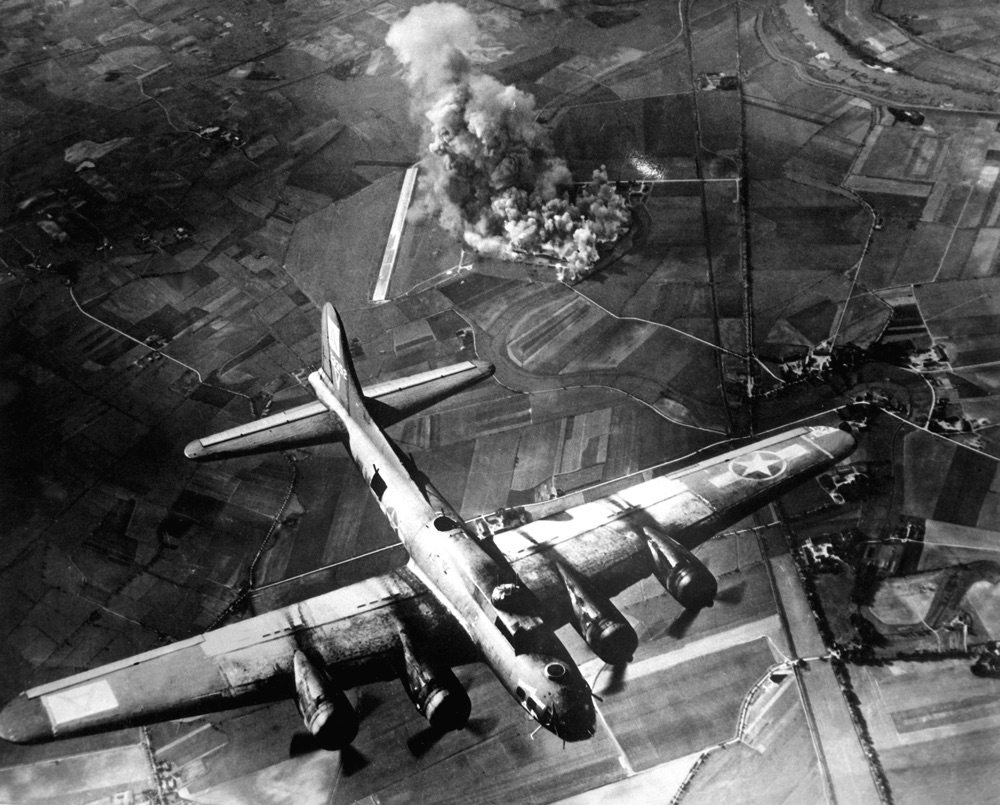WWII Bombs Had Rippling Effect on the Edge of Space

Nearly 80 years on, impacts from the violent bombings of World War II are still felt around the globe. Christopher Scott would know —two of his aunts were killed at just 9 and 11 years of age during the London Blitz, Nazi Germany's eight-month onslaught against the British.
Those aerial raids didn't just have rippling effects through generations of families. Scott, who is a space and atmospheric physicist at the University of Reading in the U.K., recently found that the bombs were felt at the edge of space, too.
By combing through archival data, Scott discovered that shock waves from the bombs briefly weakened the ionosphere, the outermost layer of Earth's atmosphere. [10 of the Most Powerful Explosions Ever]
From lightning to bombs
Between around 50 and 375 miles (80 and 600 kilometers) above the ground, the ionosphere is where auroras are created and where astronauts on board the International Space Station live. Atoms of gas in this layer of the atmosphere get excited by solar radiation, forming electrically charged ions. The density and altitude of electrons, the negatively charged particles, in the ionosphere can fluctuate. [Infographic: Earth's Atmosphere Top to Bottom]
"The ionosphere is far more variable than can be explained by solar activity," Scott told Live Science.
Scott's previous research had shown that lightning could enhance the ionosphere. He wanted to find out if this was due to the explosive energy of lightning or its electrical charge. So, he set out to look for well-documented explosions on the ground, and to compare the historical data with archival data from the Radio Research Centre in Slough, where scientists had measured the density ionosphere using radio pulses sent over a range of shortwave frequencies.
Scott said he originally intended to look at the effects of the London Blitz, but little information survives about the timing and munitions used for these raids. As an alternative, Scott's colleague Patrick Major, a historian at the University of Reading, provided a database on the bombing of Berlin between 1943 and 1944 and directed Scott to other data sets about Allied air raids in Europe.
Sign up for the Live Science daily newsletter now
Get the world’s most fascinating discoveries delivered straight to your inbox.
Shock waves
Each raid released the energy of at least 300 lightning strikes, Scott said, and historical accounts from the ground attest to the far-reaching power of bombs like the 22,000-lb. (10,000 kilogram) British "Grand Slam."
"Residents under the bombs would routinely recall being thrown through the air by the pressure waves of air mines exploding, and window casements and doors would be blown off their hinges," Major said in a news release.
When the researchers looked at the ionosphere-response records around the time of 152 large Allied air raids in Europe, they found that the electron concentration significantly decreased due to the shock waves from the bombs. The findings were published today (Sept. 25) in the journal Annales Geophysicae.
"I was able to see an effect in the U.K. ionospheric records from bombing over 1,000 km [620 miles] away," Scott said. "I was surprised by that."
Ingo Mueller-Wodarg, a planetary scientist at Imperial College London who was not involved in the study, said the research is "a neat demonstration of how the ionosphere is affected by activity on the ground, despite being many tens to hundreds of kilometers above the ground."
The effects of the shock waves would be temporary, Scott said, lasting under a day. "The ionosphere is largely controlled by solar radiation," he told Live Science. "The bombing represents a small impact by comparison."
Scott added that the ionosphere weakening may have affected the efficiency of shortwave radio communication, which relied on the ionosphere to reflect the signals over long distances.
More modern technologies, such as GPS, are affected by disturbances in the ionosphere. Another study published earlier this year found that the massive shock wave from a 2017 launch of a SpaceX Falcon 9 rocket created a temporary hole in the ionosphere, which may have disrupted navigation signals for an hour or two afterward.
Next steps
Mueller-Wodarg noted that there has long been speculation on whether earthquakes affect the ionosphere, with mixed results. "This study lends strong support to the suggestion that events on the ground which generate any kind of shock wave or strong impulses should be able to be felt in the ionosphere," Mueller-Wodargtold Live Science.
Scott said he also wants to find out if thunderstorms, volcanoes and earthquakes can be detected using similar methods.
He is also currently digitizing earlier U.K. ionospheric data with the intention to put this information online, so that volunteers can help identify more effects on the ionosphere. Doing so might help Scott understand why lightning has an impact on the ionosphere.
"The ionospheric layer that we saw responding to the bombing was much higher than the one used in the lightning study, as it was the only one for which digital data currently exist," Scott said. "This is one of the reasons why I want to digitize the ionospheric data, so that we can look to see if the layer that was enhanced by lightning is also enhanced by the bombing. Only then can we say for sure if the lightning effect is due to shock waves or an electrical current —or both."
Original article on Live Science










